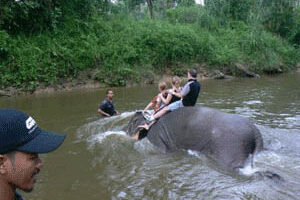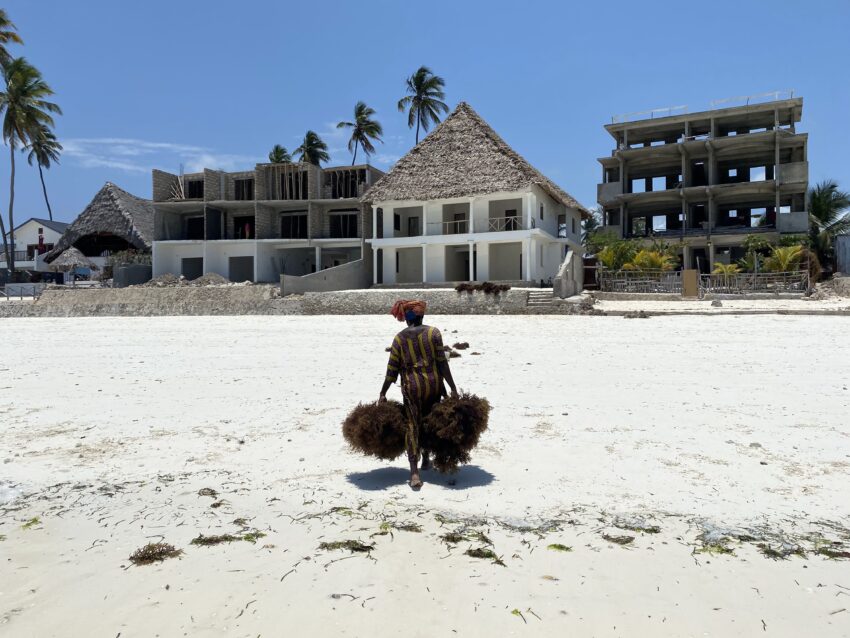
A Journey through Lesser-Known Southeast Zanzibar’s Wonders
By Annie Chen
GoNOMAD Senior Writer
The largest city of Zanzibar, Stone Town, often gets the most visitors and name recognition due to its history and size. The north of the island has a reputation for the finest beaches with powder, white sands. However, I found the richest experience to be on the southwest coast of the island.
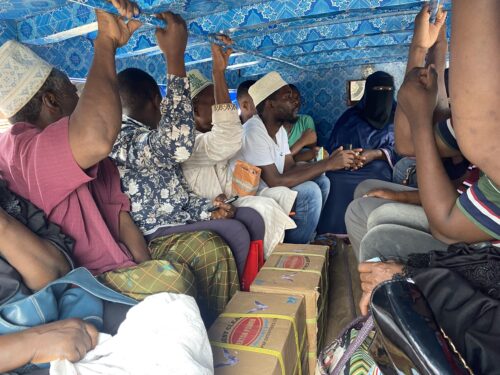
Bussing Around Zanzibar
From the center of Stone Town, the most affordable way to get to the southeast coast is not the most direct, but definitely an authentically local experience. There are minibusses, called dala-dalas, that can go long or short distances for less than $2 USD.
There are two types of dala-dalas, and there is no rhyme or reason for which one pulls up next in line. The first kind is a modern, Toyota coaster bus, seating roughly 30 people in pairs with primarily working windows.
It is generally quite spacious, and only on one or two occasions did I see people standing in the middle aisle without a seat on a ride.
I arrived at the Tasakhtaa Global Hospital at the edge of town and caught this modern dala-dala to the Kwerekwe market for 400 shillings easily enough. After being redirected several times at the mention of “Paje”, I found myself standing in front of the second type of dala-dala.
The traditional mini-bus is closer to an open-back truck bed with skinny, semi-cushioned benches facing one another. There are small metal steps to climb into the back. For anyone taller than 170cm, or 5 foot 6 inches, there will be some hunching over required, as the covering of the truck bed sits quite low.
If the dala-dala is packed, there is also minimal legroom, as I quickly found out. While the dala-dalas do leave when the back isn’t full yet, it quickly does reach maximum capacity, and then some.
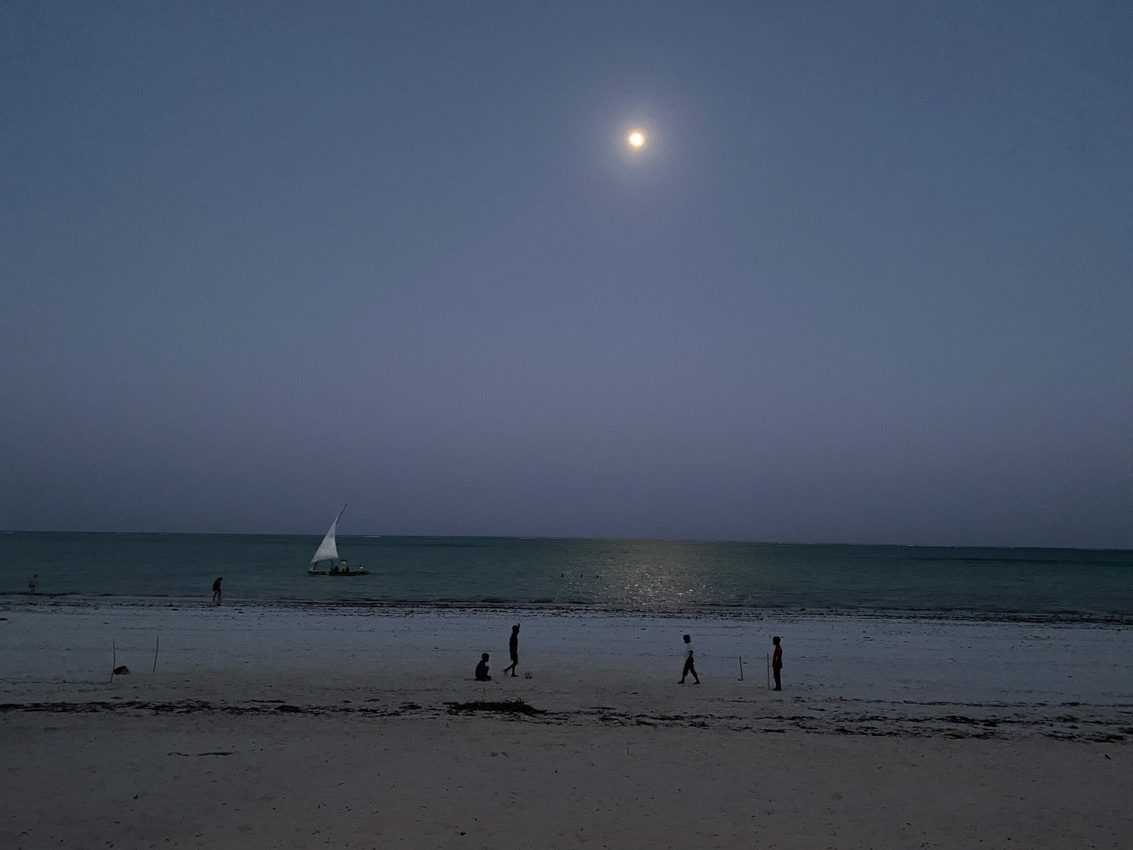
Two fortunate women were occupying the front seat with the driver. A young man hung from the wooden bars off the back of the dala-dala, calling out as we passed by bus stops and collecting coins as people boarded. I crammed into one corner, hooking my arms outside of the bus to position myself better as I settled in for a bumpy ride.
Several times, passengers would lug over bushels of firewood, canvas sacks of produce I couldn’t identify, or plastic chairs which had to be tied down with rope. After some loud clunks on the roof of the dala-dala, we were on our way again.
Beach Hopping
Two and a half hours later, I dropped 2,000 shillings into the young man’s hands and ungracefully hopped down. My first destination from Paje was actually the next beach over: Jambiani.

I wanted to visit Kuza Cave before it was too dark, and quickly waved down a boda-boda, a motorcycle-for-hire. We negotiated on 2,000 tzs for the 15-minute ride to the neighboring community. At the main road turn-off, I tapped his shoulder to hop off and walked inwards.
The road was muddy but relatively straight, and I passed an elementary school with uniform-clad students playing in their fenced-in field. Inspirational quotes in English are painted on the walls of the building.
Curious teachers and a motorcyclist glanced as I passed by, turning at a road marker at a fork in the road. Ten minutes later, I followed a van full of tourists into a small parking lot where I saw a big wooden sign for the cave.
The visitor welcome center shows the opening hours of 8:30 a.m. to 6:30 p.m. 7 days a week, and the price — $10 USD — is above the reception desk. Local goods like beaded bracelets and Africa-shaped keychains are displayed in front of chairs and tables for people to rest in the shade.
A semi-circle arrangement shows where the drumming demonstrations are normally held, and a small stage for live musical and dance performances is in the back. To one side, an open kitchen boasts cooking classes where tourists can learn about local cuisine for 20,000 tzs a person.
A Cool Dip in Kuza Cave
After I paid, a young man guided me into the forest through a nondescript pathway. As we headed down some stairs, he explained that the mineral water in the cave was imbued with healing qualities in such a way the ancestors would say that a trip to the cave was like “going to the hospital and the spa at the same time.” We turned a corner, and the 50-meter long oval sinkhole opened up in front of me.
My guide had mentioned the name kuza came from a Swahili word for birth or something coming into being. As I gingerly headed down the stairs, holding onto a thick rope handle and watching my step for the slippery sloped edges, I could feel the legendary power the people of generations past believed in as the dampness and tranquility took over.
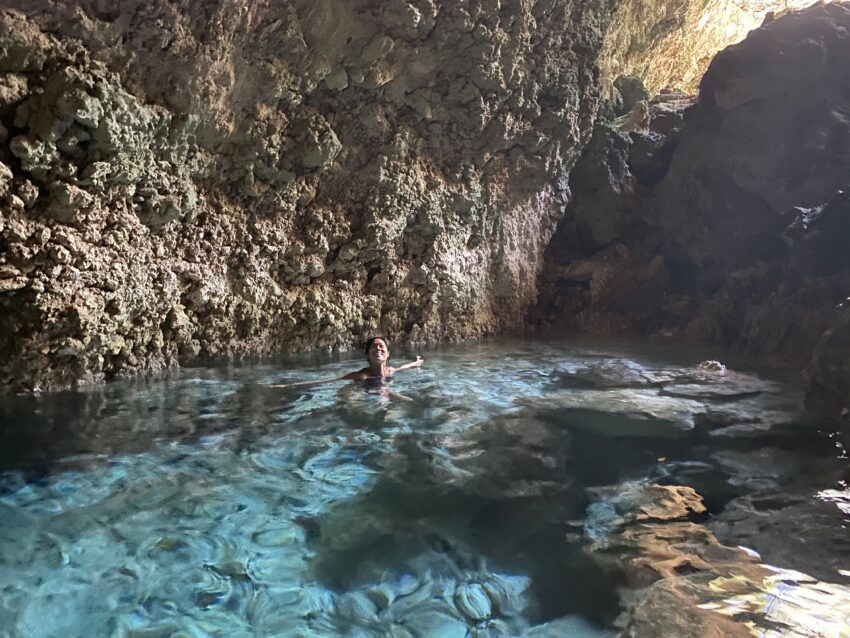
Only a few other people were there, and I found a relatively dry patch next to their backpacks and sandals to leave my belongings among the uneven rock surface. The guide had warned me that there was never any direct sun exposure in the cave, so the water was going to be chilly.
However, considering I’d just spent the last 15 minutes walking in 30°C without any shade, I slid straight into the refreshing, clear water without any hesitation.
Immediately, I wish I’d brought my water shoes. The bottom of the cave range in depth, from two to three meters in some areas to smooth mossy rock which I could hold to guide myself around. As soon as I pushed off and swam into the deeper portion of the cave, though, my toes felt sharp rocks on the bottom and I emerged in the end with a dozen cuts on my feet.
When I’d relaxed long enough, I pulled myself out around a French couple and gathered up my things as two families with five young children in tow trickled in through the entrance, chattering excitedly and searching for their goggles.
Zanzibar’s Beauty Secret: Seaweed
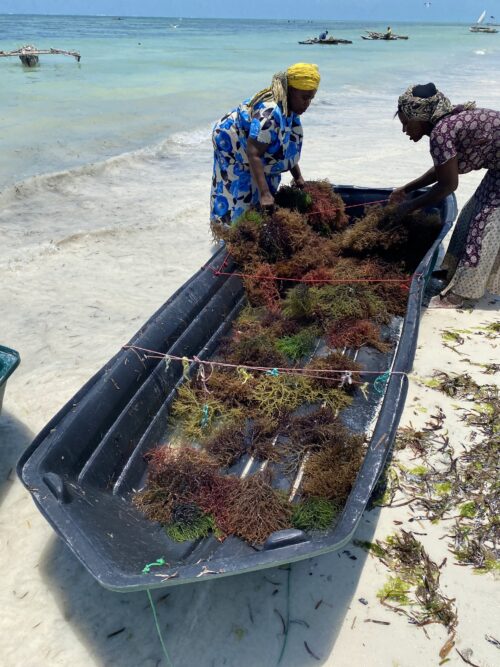
Back in Jambiani, I followed my phone’s map towards the Mwani seaweed center.
Mwani is Swahili for “seaweed” and is said to contain proteins and enzymes which bring about moisturizing and anti-aging qualities.
These women of east Zanzibar formed an NGO to harvest this natural and valuable product, turning it into organic beauty and skincare products such as soap, hand cream, shower scrubs and massage oils.
Different scents come out when it’s combined with other ingredients, like clove or turmeric — ingredients commonly found in Zanzibar, also known as the Spice Island.
Unfortunately, the center wasn’t open at that hour. A man informed me that the women normally run their soap-making workshops at 9 a.m. when the tide washes in fresh seaweed for the picking.
He directed me back towards the beach, where there was a seaweed drying and collection center.
Large plastic tarps were laid out in front of the small building, with hundreds of seaweed pieces spread out on top. Wooden makeshift racks stood behind the tarps with seaweed draping from them in shades of olive green to faded pink and purple.
Two women trekked back and forth between the drying area and a fishing boat that had been pulled onto the shore. I peeked inside and saw the remains of the morning haul of seaweed, ready to be bundled and dried.
Some local men watching over the seaweed gave me toothy grins and gestured for me to touch it. It turned out to be as slimy as I’d imagined.
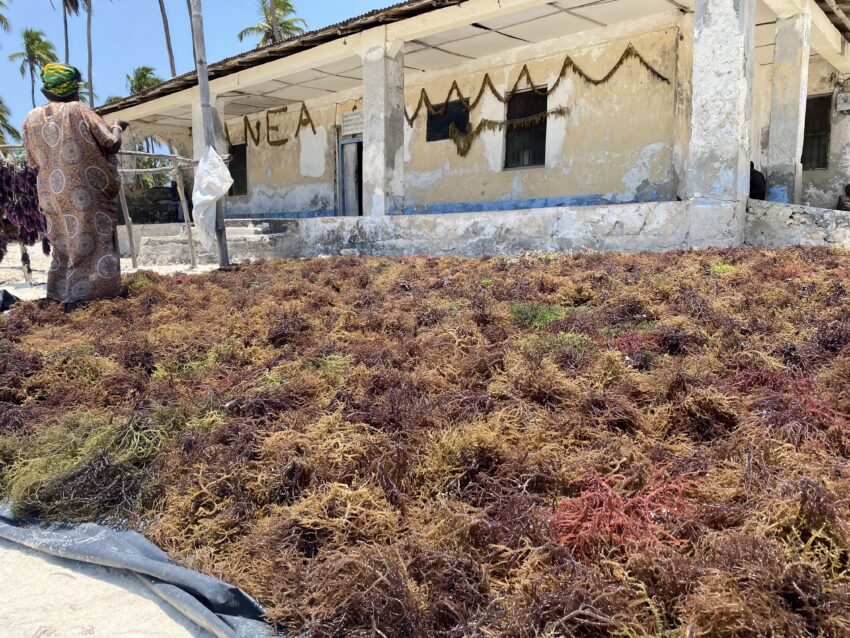
Back in Transit
On my way to my third stop, I passed stands in the road with packs of baobab pits coated with red sugar for 1,000 shillings. I sucked on the sour treats as I inspected some cow bone keychains, ignoring the incessant calls of “rafiki, come inside, free to look, hakuna matata” and “hey! Hey, Squid Game!” from young men lounging in the sand.
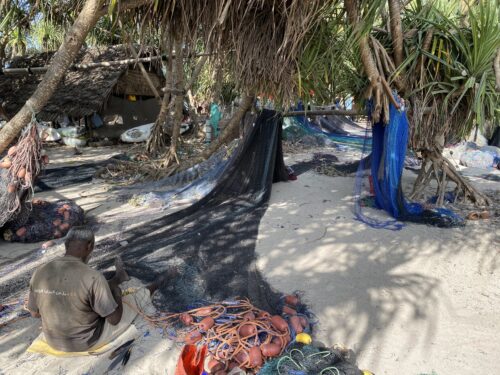
Another turn brought me to woodworkers shaping long planks of wood to build a boat from local trees, and fishermen untangling their nets from the morning’s shift.
Along with their wives and children, the fishermen tediously inspected every thread of the net for holes and knots which would interfere with the following morning’s catch.
At the dala-dala stop, I plopped down on a rock in the shade and waited, knowing the minibusses tend to pass by every 10 to 15 minutes.
Only a few minutes had passed by before a young man dressed in traditional Maasai clothing sauntered by and stopped in front of me.
Meet Isaac
Isaac, as he introduced himself, was from Arusha, although the Maasai people were spread all throughout Kenya and Tanzania.
When I asked why he was so far from home, he explained that many Maasai men were in Zanzibar to make a living, as it was difficult, especially during the coronavirus pandemic, to find employment.
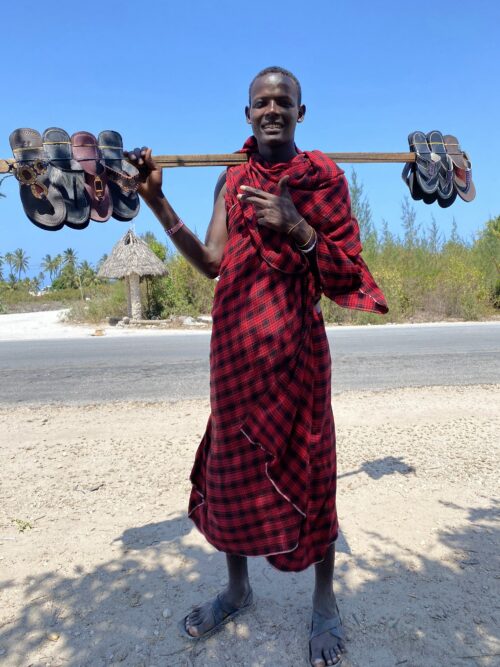
While he didn’t go into details, I later discovered that the primary market for Maasai men was in sex tourism, and there were frequent female tourists who came to the island specifically for it.
Isaac’s red-and-black-checkered cloth draped over his neck and torso, and he elaborated that red was the most traditional color for his people, since it symbolized courage and helped to fight off predators in the wild. A long knife was hooked onto a belt-like rope, and a Maasai club, called the rungu, hung off the other side.
As I saw my dala-dala pull up in the distance, he slung his long wooden pole over his shoulder towards me and asked if I needed a new pair of sandals.
He had seven pairs strung together on the pole, made from recycled rubber tires, with traditional Massai beading for 5,000 tzs each. I politely declined, then with a wave of good-bye, hopped onto the minibus.
Monkey Business at Jozana Chwaka
Twenty minutes and 1,000 tzs later, I was in front of the entrance to Jozani Chwaka Bay National Park. At 50 square kilometers, it’s the only national park on the island, and the only place to find the endemic Zanzibar red colobus.
The main parking lot was filled with white tourist vans and guides, as groups filed into the open-air reception area.
Signs were posted everywhere warning of the dangers of pollution and smoking in a dry forest area.
I handed over $10 USD for the entrance fee, which came with an obligatory guide, and waited for a large enough group to gather before we left.
The guide was divided into three parts; the first one was the primary headliner for the park, the colobus monkeys.
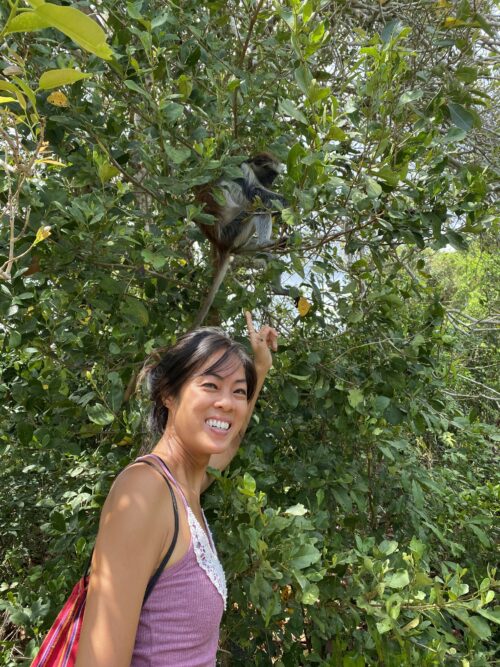
Caravan of Cars
In a caravan of cars, we followed the guide in the first vehicle a few minutes away to the center of the forest, where we disembarked and trailed behind him in a single file line.
Over thorny branches and around mud puddles, our group shuffled through the dry leaves in silence before he hushed us quickly and pointed upwards.
Quick movements drew our attention to the colony of colobus monkeys about three meters above our heads.
Their bodies were long and skinny, with distinctive red-brownish backs and a white underbelly. Their long tails whipped around as their black faces with wispy white hairs gazed down curiously at us.
The guide pointed out one of the alpha males, who are outnumbered by the females and babies.
One crept down a branch towards us, completely unafraid, and got within one meter of a smartphone videoing his every move.
I was convinced that like the monkeys I saw in Bali do, it would snatch the phone and scamper away, but it just tilted its head and blinked right at the camera.
Mangroves and Miracle Cures
We headed into the mangroves next, with humid swamp-like darkness and the hum of mosquitos.
Our guide indicated the roots of the trees, some of which had dozens of shoots into the water-rich soil, in contrast with the baby saplings that were still young and growing.
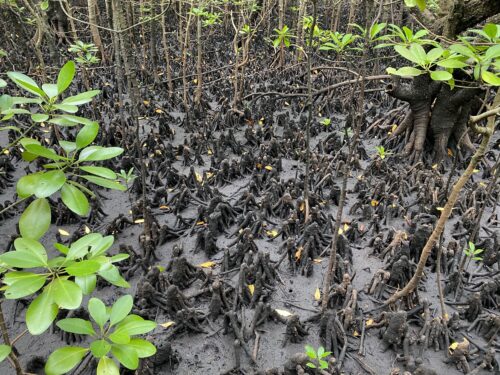
Upwards of 2,500 species of crustaceans depend on the mangroves for survival. Through one ray of light, I briefly spotted tiny, camouflaged crabs scuttling on some of the lower branches.
Another pair of legs stuck out from holes in the ground, as they tended to stay near the water source.
The mangroves are essential for the local ecosystem as they oxidize the area and the soil, provide homes for over 30 types of fish and other creatures which lay their eggs there during the high tide, and prevent soil erosion.
The third part of the tour was the rainforest walk, where the guide commented on every other plant we passed and its various traditional uses.
These included berries and leaves which could be crushed into a remedy for food poisoning, medication to induce labor, or a powder to regulate the menstruation cycle.
Towards the end, he straightened up as he patted the thick branches of a nearby bush and declared that it was the most important plant for the males in the group. After all, “if machine go kaput, you take this and you be busy man!”
- The Interesting Bamileke Region of Cameroon - September 11, 2023
- Mombasa, Kenya: Crocs, Snakes and Empowered Artists - April 9, 2023
- Cameroon’s Douala-Edéa National Park - February 11, 2023



